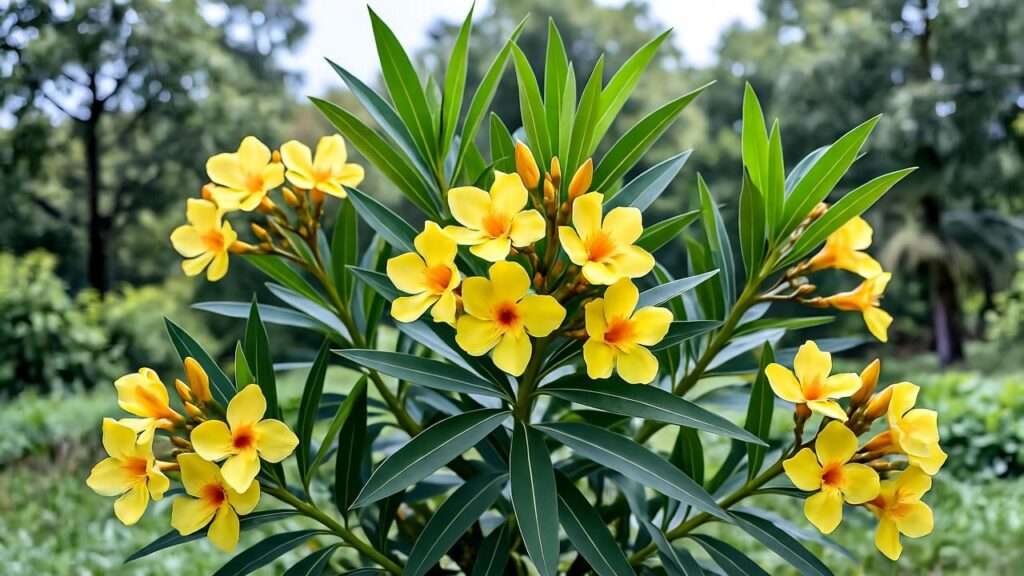Picture this: a cascade of radiant yellow blooms spilling over your garden, catching every eye with their tropical charm. The yellow oleander plant (Thevetia peruviana), with its glossy evergreen leaves and vibrant flowers, is a showstopper that can elevate any outdoor space. Whether you’re a seasoned gardener or a beginner, mastering the care of this stunning plant can transform your landscape into a tropical paradise. But beware—its beauty comes with a responsibility to understand its needs and toxicity. In this comprehensive guide, you’ll uncover expert-driven tips to grow and maintain a thriving yellow oleander, ensuring it flourishes safely and vibrantly for years to come. From ideal planting conditions to troubleshooting common issues, we’ve got you covered with practical, actionable advice rooted in years of horticultural expertise. Let’s dive in! 🌿
1. What Is the Yellow Oleander Plant? 🌿
1.1 Overview of the Yellow Oleander
The yellow oleander, scientifically known as Thevetia peruviana, is a tropical evergreen shrub or small tree cherished for its trumpet-shaped, golden-yellow flowers and lush, glossy foliage. Often called the “lucky nut” or “be-still tree,” this plant hails from Central and South America but has found a home in warm climates worldwide. Growing 6–12 feet tall, it’s a versatile addition to gardens, patios, or even large containers. Its vibrant blooms appear year-round in frost-free regions, making it a favorite for ornamental landscaping.
1.2 Unique Characteristics and Benefits
The yellow oleander’s appeal lies in its striking aesthetics and adaptability. Its bright flowers and shiny leaves create a bold focal point in any garden, complementing tropical or Mediterranean designs. Beyond beauty, it attracts pollinators like bees and butterflies 🐝, supporting local ecosystems. In some cultures, the plant holds traditional significance, with its seeds historically used in herbal remedies—though only under expert supervision due to its toxicity. For gardeners, its drought tolerance and low-maintenance nature make it a rewarding choice for warm climates.
1.3 Important Safety Note ⚠️
Before diving into care, a critical warning: all parts of the yellow oleander are highly toxic if ingested, posing risks to humans, pets, and livestock. The plant contains cardiac glycosides, which can cause severe illness or worse. Always wear gloves when handling, keep it away from children and animals, and dispose of trimmings safely. Expert tip: Label your plant or inform household members about its dangers to prevent accidents.
2. Ideal Growing Conditions for Yellow Oleander ☀️
To ensure your yellow oleander thrives, you need to replicate its native tropical environment. Here’s how to set it up for success.
2.1 Climate and Temperature
Yellow oleander flourishes in USDA hardiness zones 9–11, where temperatures rarely dip below 50°F (10°C). It loves warm, sunny climates, making it ideal for regions like Florida, Southern California, or coastal areas. In cooler zones, grow it as a potted plant and bring it indoors during winter. Avoid exposing it to frost, as it’s highly sensitive to cold.
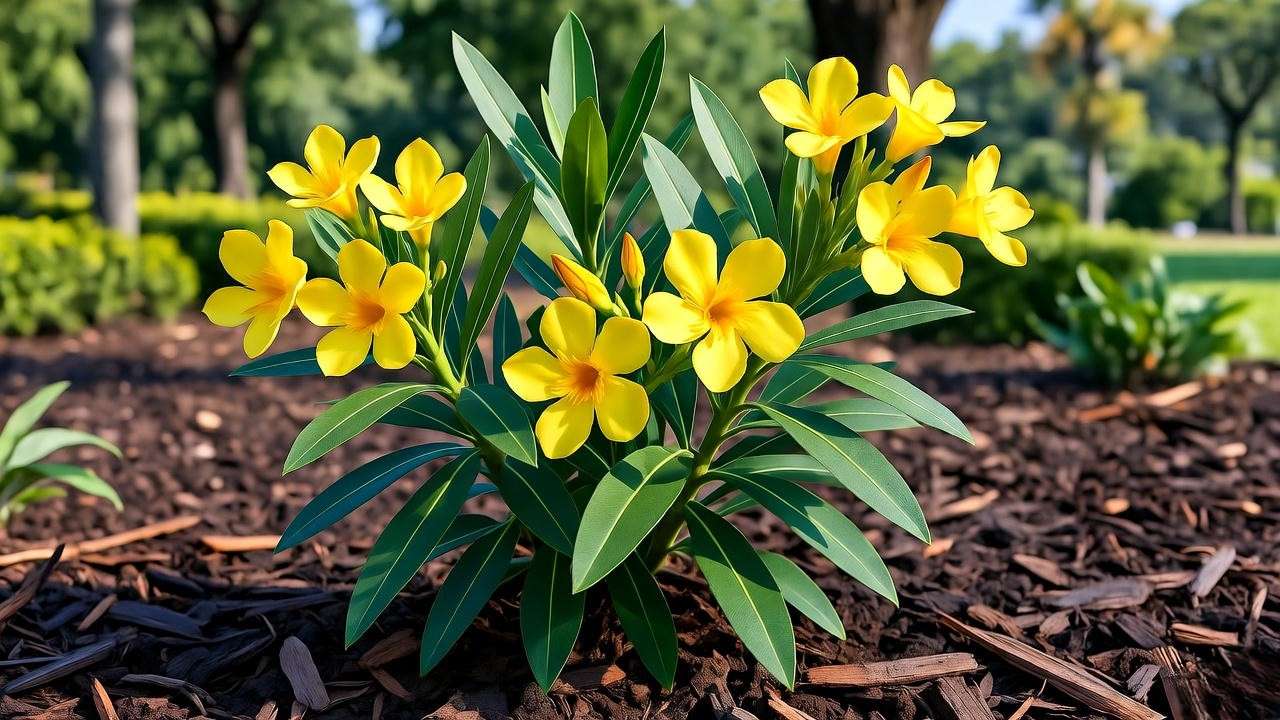
2.2 Sunlight Requirements
This plant craves sunlight! Aim for 6–8 hours of direct sun daily to encourage prolific blooming. Partial shade is tolerable but may reduce flower production. If grown indoors, place it near a south-facing window or use grow lights to mimic natural sunlight. Expert insight: Insufficient light often leads to leggy growth and sparse blooms, so prioritize a sunny spot.
2.3 Soil Preferences
Yellow oleander prefers well-draining, slightly acidic to neutral soil (pH 6.0–7.0). A mix of loamy soil, sand, and organic matter like compost works best. Heavy clay soils can trap water and cause root rot, so amend with perlite or sand if needed. Pro tip: Test your soil’s drainage by watering a small area—if water pools for hours, improve drainage before planting.
2.4 Watering Needs
Moderate watering keeps yellow oleander happy. Water deeply once a week during the growing season, allowing the top inch of soil to dry out between sessions. In hot, dry climates, you may need to water twice weekly. For potted plants, ensure pots have drainage holes to prevent waterlogging. Adjust watering in winter to avoid soggy roots.
3. Planting Your Yellow Oleander: Step-by-Step Guide 🌱
Ready to plant? Follow these steps to give your yellow oleander the best start.
3.1 Choosing the Right Location
Select a sunny, sheltered spot in your garden or patio. Yellow oleander needs protection from strong winds, which can damage its delicate branches. Space plants 6–10 feet apart to allow for their mature size and to ensure good air circulation. For container gardening, choose a spot with ample sunlight and easy access for maintenance.
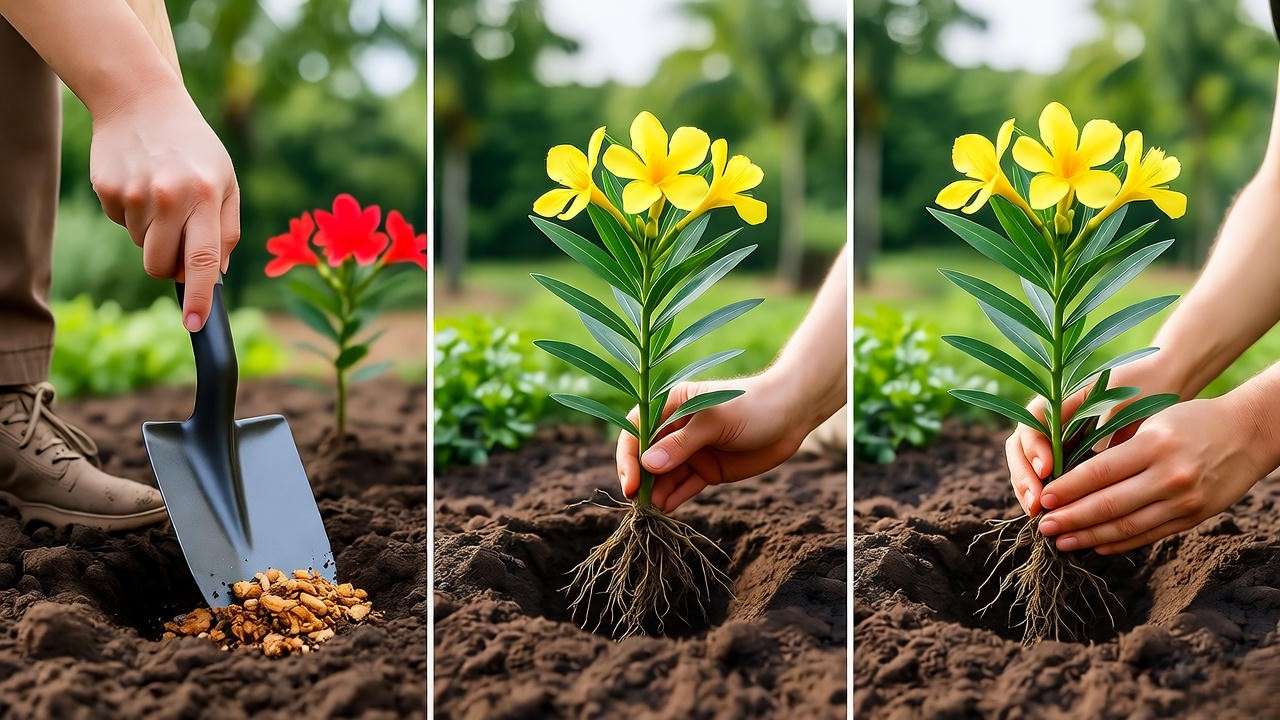
3.2 Propagation Methods
You can grow yellow oleander from seeds or cuttings.
- Seeds: Soak seeds in warm water for 24 hours to soften their hard coating, then plant in a well-draining seed-starting mix. Germination can take 2–4 weeks, so be patient. Keep the soil consistently moist and warm (70–80°F).
- Cuttings: Take 6–8-inch semi-hardwood cuttings in spring, dip in rooting hormone, and plant in a mix of sand and peat. Keep cuttings humid by covering with a plastic bag until roots form.
Expert tip: Seeds are slower but rewarding; cuttings offer faster results for impatient gardeners!
3.3 Planting Instructions
- Dig a hole twice as wide and as deep as the root ball.
- Mix compost or aged manure into the soil to boost nutrients.
- Place the plant in the hole, ensuring the root crown is level with the soil surface.
- Backfill with soil, tamp gently, and water thoroughly.
- Add a 2-inch layer of organic mulch (e.g., bark or wood chips) to retain moisture and suppress weeds.
4. Ongoing Care for a Thriving Yellow Oleander 🌸
Consistent care is key to keeping your yellow oleander vibrant and healthy.
4.1 Watering Routine
Stick to a weekly deep watering schedule during spring and summer, reducing to every 10–14 days in cooler months. Check soil moisture with your finger—if the top inch is dry, it’s time to water. Overwatering can lead to yellowing leaves or root rot, while underwatering causes wilting. Pro tip: Use a moisture meter for precision, especially for potted plants.
4.2 Fertilizing for Optimal Growth
Feed your yellow oleander with a balanced, slow-release fertilizer (e.g., 10-10-10) in early spring and mid-summer. Apply according to package instructions, avoiding overuse, which can burn roots or cause excessive leaf growth at the expense of flowers. For organic options, try compost tea or fish emulsion. Expert insight: Phosphorus-rich fertilizers (higher middle number, e.g., 5-10-5) can boost blooming.
4.3 Pruning and Shaping
Prune in late winter or early spring before new growth begins. Remove dead, damaged, or crossing branches to improve air circulation and shape the plant. Use clean, sharp shears and wear gloves to avoid contact with toxic sap. For a bushier look, trim back long shoots by one-third. Safety reminder: Dispose of clippings in sealed bags to prevent accidental ingestion by pets or wildlife.
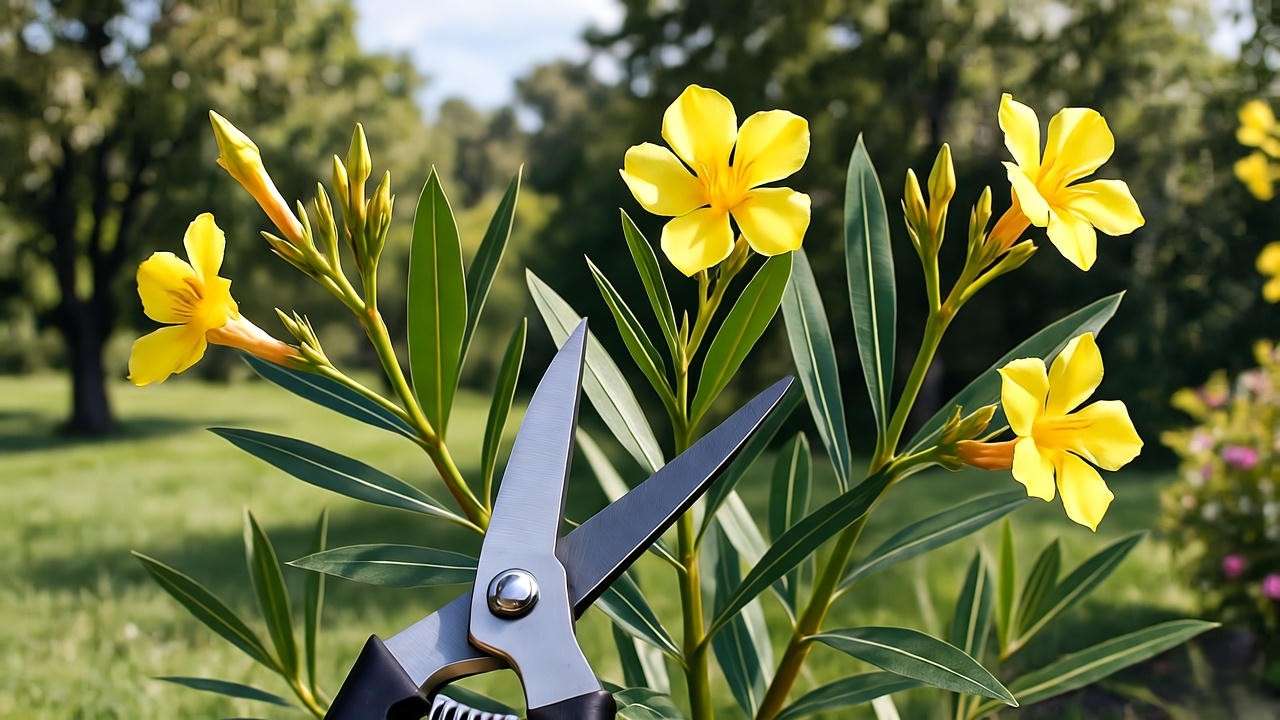
4.4 Pest and Disease Management 🐛
Yellow oleander is relatively pest-resistant but can attract aphids, spider mites, or scale insects. Treat infestations with neem oil or insecticidal soap, applied early in the morning or late evening. Common diseases include:
- Root rot: Caused by overwatering or poor drainage. Improve soil aeration and reduce watering.
- Leaf spot: Fungal infections from prolonged leaf wetness. Remove affected leaves and apply a fungicide if needed.
Pro tip: Regularly inspect leaves and stems to catch issues early.
5. Troubleshooting Common Yellow Oleander Problems ⚙️
Even with the best care, your yellow oleander plant may face challenges. Here’s how to diagnose and fix common issues to keep it thriving.
5.1 Yellowing Leaves
Yellowing leaves often signal an underlying issue. Common causes include:
- Nutrient deficiency: Lack of nitrogen or iron can cause leaves to pale. Test your soil and apply a balanced fertilizer or chelated iron supplement as needed.
- Overwatering: Soggy soil suffocates roots, leading to yellow, droopy leaves. Check drainage and reduce watering frequency.
- Poor drainage: Compacted or clay-heavy soil traps water. Amend with sand or perlite to improve aeration.
Solution: Adjust watering, test soil pH, and fertilize if needed. Monitor for improvement within 1–2 weeks.
5.2 Lack of Blooms
If your yellow oleander isn’t blooming, consider these factors:
- Insufficient sunlight: Less than 6 hours of direct sun daily can reduce flowering. Relocate to a sunnier spot or prune nearby plants blocking light.
- Improper pruning: Cutting at the wrong time (e.g., late summer) removes next season’s buds. Prune in late winter instead.
- Young plant: Plants under 2–3 years old may not bloom yet. Be patient and ensure proper care.
Fix: Optimize sunlight, adjust pruning timing, and apply a phosphorus-rich fertilizer to encourage blooms.
5.3 Wilting or Drooping
Wilting can be alarming but is often fixable. Potential causes include:
- Underwatering: Dry soil stresses the plant, causing leaves to droop. Water deeply and maintain a consistent schedule.
- Heat stress: Extreme heat can overwhelm the plant, especially in direct midday sun. Provide temporary shade during heatwaves.
- Root issues: Compacted or damaged roots hinder water uptake. Check for root rot or binding in potted plants.
Action plan: Verify soil moisture, provide shade during intense heat, and inspect roots for damage. Repot or improve soil if necessary.
6. Yellow Oleander in Containers: Tips for Small Spaces 🪴
Don’t have a large garden? No problem! Yellow oleander thrives in containers, making it perfect for patios, balconies, or indoor spaces.
- Choosing the right pot: Select a container at least 12–18 inches wide with drainage holes to prevent waterlogging. Terracotta or plastic pots work well, but ensure proper drainage.
- Soil and watering adjustments: Use a well-draining potting mix (e.g., cactus mix with added compost). Water when the top inch of soil feels dry, typically every 5–7 days.
- Overwintering indoors: In colder climates (below zone 9), bring potted yellow oleanders indoors during winter. Place near a sunny window or under grow lights, maintaining temperatures above 50°F (10°C).
Expert tip: Repot every 2–3 years to refresh soil and prevent root-binding. Check the root ball for crowding and trim if needed.
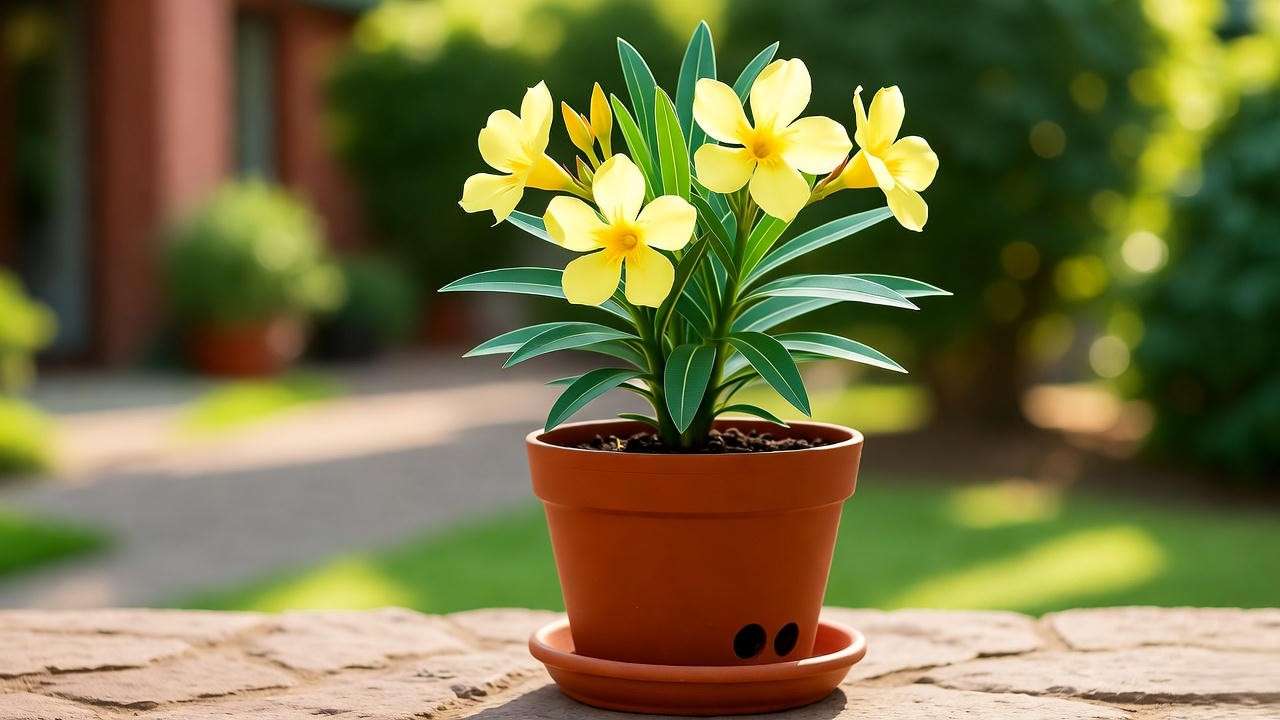
7. Landscaping with Yellow Oleander: Design Ideas 🌷
The yellow oleander’s vibrant blooms and lush foliage make it a standout in garden design. Here are creative ways to incorporate it:
- Focal point: Plant a single yellow oleander as a centerpiece in a tropical garden bed, surrounded by low-growing plants like lantana or dwarf zinnias.
- Hedges or privacy screens: Space multiple plants 6–8 feet apart to form a dense, colorful hedge. Regular pruning keeps it tidy and full.
- Complementary pairings: Combine with other tropical plants like hibiscus, bougainvillea, or bird of paradise for a vibrant, cohesive look.
Example: Create a stunning display by planting a yellow oleander in a circular bed with purple verbena and white alyssum as ground cover. The contrast highlights the oleander’s golden blooms.
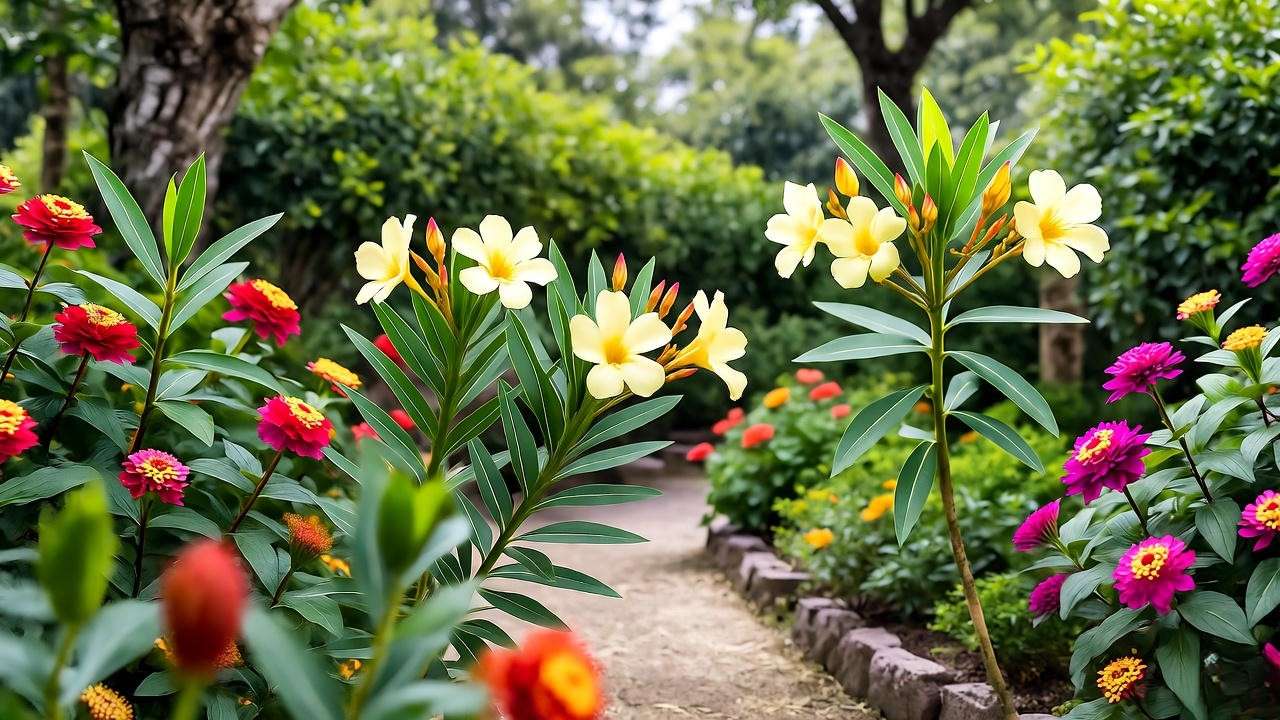
8. Safety and Ethical Considerations 🚨
Given its toxicity, responsible care of the yellow oleander is non-negotiable. Here’s how to ensure safety:
- Educate your household: Inform family members, especially children, about the plant’s dangers. Consider adding a small sign or label near the plant as a reminder.
- Responsible disposal: Bag and seal pruned branches, leaves, or seeds before disposing to prevent accidental ingestion by pets, wildlife, or curious passersby.
- Ethical gardening: Avoid planting near grazing areas, public parks, or spaces accessible to livestock. If you’re in a community garden, check local regulations.
Pro tip: If you have pets, consider fencing off the plant or growing it in an elevated container to limit access.
9. Expert Insights: Advanced Tips for Yellow Oleander Enthusiasts 🌟
Ready to take your yellow oleander care to the next level? Try these advanced techniques:
- Boost blooming: Apply a phosphorus-rich fertilizer (e.g., 5-10-5) in early spring to promote larger, more vibrant flowers.
- Experiment with grafting: For skilled gardeners, grafting yellow oleander onto a hardier rootstock can improve resilience in marginal climates. Consult a local nursery for compatible rootstocks.
- Monitor soil pH: Test soil annually to maintain the ideal 6.0–7.0 range. Adjust with sulfur (to lower pH) or lime (to raise pH) as needed.
Quote from a horticulturist: “Yellow oleander rewards patience with unmatched beauty—treat it like a prized gem in your garden!” – Dr. Maria Torres, Tropical Plant Specialist.
10. Frequently Asked Questions (FAQs) ❓
Q1: Is the yellow oleander safe to grow around pets?
Answer: No, it’s highly toxic to pets, children, and livestock. Keep it out of reach, use barriers, or opt for pet-safe plants if you have curious animals.
Q2: How fast does yellow oleander grow?
Answer: With proper care, it grows moderately fast, reaching 6–12 feet in 2–3 years. Growth is slower in containers or cooler climates.
Q3: Can yellow oleander survive frost?
Answer: It’s frost-sensitive and may die back in temperatures below 50°F (10°C). Protect with frost cloth or bring indoors in colder regions.
Q4: Why isn’t my yellow oleander blooming?
Answer: Lack of blooms is often due to insufficient sunlight, improper pruning, or a young plant. Ensure 6–8 hours of sun, prune in late winter, and wait for maturity (2–3 years).
Conclusion: Your Path to a Stunning Yellow Oleander 🌻
Growing a yellow oleander plant is a rewarding journey that combines beauty with responsibility. By providing full sun, well-draining soil, moderate watering, and safe handling, you’ll cultivate a vibrant, healthy plant that dazzles year-round. Whether it’s a garden centerpiece or a potted patio gem, your yellow oleander will thrive with the expert tips outlined here. Start planting today, share your progress in the comments, and join a community of tropical plant enthusiasts! For supplies or further advice, check out trusted nurseries or resources like your local university extension program.

